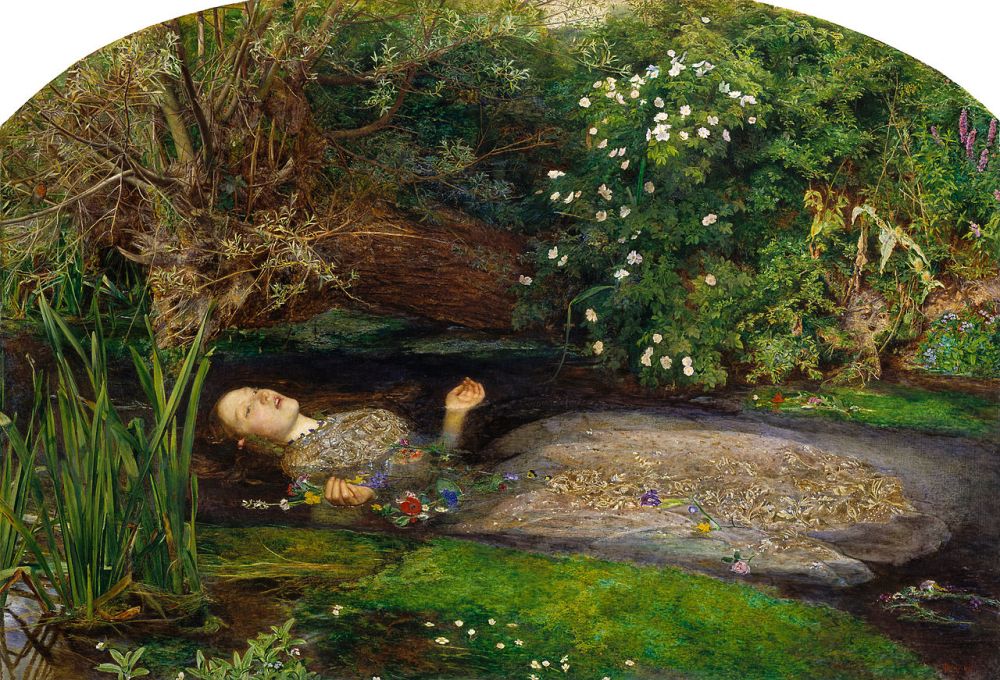In Elizabethan times, stories of witches, fairies, and all sorts of magic still had a hold on how the world was understood. Shakespeare lived in a world where the meanings of flowers still had power, a world where bay-trees could succumb to evil (Richard II) and where a ring of mushrooms heralds the arrival of fairies (The Tempest).
Even the language Shakespeare uses is coloured with flowers and other plants, their meanings shedding light on the actions of his own characters. Ophelia, tragic and ethereal in Hamlet, carries a posy of flowers as madness descends upon her. Sir John Everett Millais’ painting of Ophelia depicts her lying just before she drowns, clutching a handful flowers mentioned in the play:
Ophelia: “There’s rosemary, that’s for remembrance; pray you, love, remember: and there is pansies, that’s for thoughts.”
Laertes: “A document in madness,–thought and remembrance fitted.”
Ophelia: “There’s fennel for you, and columbines:–there’s rue for you; and here’s some for me:–we may call it herb-grace o’Sundays:–O you must wear your rue with a difference.–There’s a daisy:–I would give you some violets, but they wither’d all when my father died:–they say he made a good end. ” [Sings] “For bonny sweet Robin is all my joy–”
Hamlet, Act IV, Scene V
Here Shakespeare enumerates the meaning of these flowers, though it’s likely that much of his audience would already know their symbolism. And yet, in this passage there are no stage directions, no way to know how Ophelia is acting, or to whom she is handing the flowers. In most productions today, Ophelia hands the flowers out, their meanings sharp barbs to their recipients. Fennel and Columbine for King Claudius—columbine for the fool, its flower the hat of a court jester; fennel for flattery, a common affliction for a king, and perhaps also to ward off his own evil spirit. Queen Gertrude is presented Rue—for bitterness and for faithlessness. The daisy is often given to no one—a symbol of innocence and repentance, Ophelia cannot see anyone in the court who deserves that.

Her brother Laertes is handed pansies and rosemary, thoughts (related to the French word “pensée”) and remembrance, for both their slain father and perhaps Ophelia herself. But Ophelia has no violets—they’ve “wither’d all” after Hamlet murdered her father. Violets, symbols of modesty, innocence, and faithfulness, have withered away— as has Ophelia’s innocence and faith. And so violets become associated with death, harking back to the legend of the Earth god Attis who, while dying, bled onto the ground from which violets would later spring.
Shakespeare’s audience would have well understood the power of the flowers Ophelia is handing out. To see that, even in her so-called madness, Ophelia is perhaps able to see the most truth. She laid bare the corruption in the hearts of the King and Queen in a handful of flowers.
Millais’ painting of Ophelia as she drowns surrounds her with other flowers not mentioned in Hamlet, but which to the viewer heighten the tragedy surrounding her. Forget-me-nots, the absent violets, these are found strewn around Ophelia’s body, alongside pansies, daisies, and more. A weeping willow’s branches cascade over her prone body, itself a symbol of grief and lost love. This depiction of Ophelia surrounded by plants rich in meaning is part and parcel of Shakespeare’s symbolism, still known and understood in the 19th century.

Yet today this language of flowers has been all but lost for many of us. We might still recognise some of their meanings—red roses for love, white lilies for sympathy— but many plants (particularly those less striking and not sold in supermarket florists) are essentially blank slates. Indeed, the plants themselves are often unidentifiable, unseen in the urban areas where many of us spend the majority of our lives.
It’s perhaps telling that we’ve lost much of this connection with nature. Not so much that we can’t associate the same meanings to many of these flowers than in Shakespeare’s day, but rather that we have hardly any meanings to associate with them at all. Our lives are no longer so tied to the natural world, to the passing of the seasons and the blossoming of different flowers.
If Shakespeare were writing today, would plants have played such crucial descriptive roles? It’s hard to say—certainly it would be harder to sell to a sceptical public. Shakespeare today benefits from its cachet—we expect Shakespeare to be on occasion difficult to understand, to have themes and concepts alien to 21st century society. If a modern playwright were to challenge their audience to understand the meanings of different flowers, and use them to illustrate key moments in drama, I can’t help but think that they’d find us a tough crowd.
If you’re interested in learning more about the meanings of flowers and their use in Shakespeare’s plays, take a look here at “Folk-lore of Shakespeare” by T. F. Thistleton Dwyer. I’ve also linked through to sources and further discussion in the blog above.